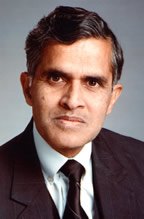Hazard + Safeguard = Risk
Outstanding Professor Lecture Zeros In on Assessing Risk
April 8, 2008
By Russ L. Hudson
There is some hazard in almost anything, but if enough precautions are taken, the chance is minimized.
Crossing a street is common, but crossing blindfolded increases the level of risk to a point where it may be too much to accept. Crossing with the light, using the crosswalk and looking both ways makes the possible hazard acceptable.
It can be more complicated to determine risk in fields such as manufacturing, aviation and medicine.
The mathematical models developed and tested over the years to determine the risk in such fields will be explained on Monday, April 14, by Chandrasekhar Putcha, professor of civil and environmental engineering and the 2007 recipient of Cal State Fullerton's Outstanding Professor Award.
The Outstanding Professor Lecture, "Risk: Concept and Multidisciplinary Applications," will be held at 11 a.m. in Portola Pavilion of the Titan Student Union.
"This is a subject that has been studied for a very long time," Putcha said. "Mathematical models have been developed to help determine each factor and the interactions of the factors. For example, assessing a hazard and its level: Is it a danger to human life? A danger to human health? A danger to reputation? A financial danger?"
"How likely a hazard is to occur also is a 'must' factor. It could be a very high-level factor, such as a danger to human life, but the likelihood of it occurring might be so remote as to be very near zero," the professor said. "In another instance, there may be a much higher chance of an occurrence, but it may be almost entirely financial with, perhaps, some risk to reputation.
"In simplified terms, the seriousness plus the chance of occurrence largely determine how much of a hazard it is," Putcha said, "then, based on that, mathematical models can be used to determine the amount and kinds of resources to apply to the hazard and that becomes the risk plan.
"Resources," explained Putcha, "can mean money, changes in method of manufacture, procedural changes, various controls, and adjustment to reputation and public image."
Putcha, a 27-year teaching veteran at Cal State Fullerton, is the first educator from the College of Engineering and Computer Science to be chosen for the outstanding professor honor.
"I've got to say, Dr. Putcha, you stand out as a model for our Cal State Fullerton faculty," said University President Milton A. Gordon when announcing the honor in a surprise, unannounced visit to Putcha's classroom about a year ago.
"I thank you for bringing this to our college, Dr. Putcha, and hope it is the first of many more," added Raman Unnikrishnan, dean of the College of Engineering and Computer Science.
Putcha's primary research is in reliability and risk analysis, which has resulted in more than 100 referred research papers. Research funding has come from several sources, including the U.S. Army, Navy and Air Force, and the Marshall Space Flight Center. His research has included analyses of physical and medical factors; traffic flow; various stresses on wharves, bridges and buildings; and Space Shuttle fuel tank attachments.
The researcher has been a visiting or associate professor several times, including at the University of Alabama in Huntsville; Stevens Institute of Technology in Hoboken, New Jersey; West Virginia University in Morgantown; Polytechnic Institute of New York in Brooklyn; Carleton University in Ottawa, Canada; and University of Waterloo in Waterloo, Canada.
Putcha, who earned a doctorate in structural engineering from the Indian Institute of Technology, has been an employee of or consultant for Northrop Grumman Corp., Boeing, Rockwell International, National Technical Systems and TRW Defense Systems Group. In addition, since 1992, Putcha has been recognized 27 times for his service, research and achievements, including more than a dozen times by the U.S. Air Force, Navy and Army, and NASA.
His April 14 talk is sponsored by Cal State Fullerton's offices of the President and Vice President for Academic Affairs, President's Associates, Academic Senate and Faculty Development Center.

